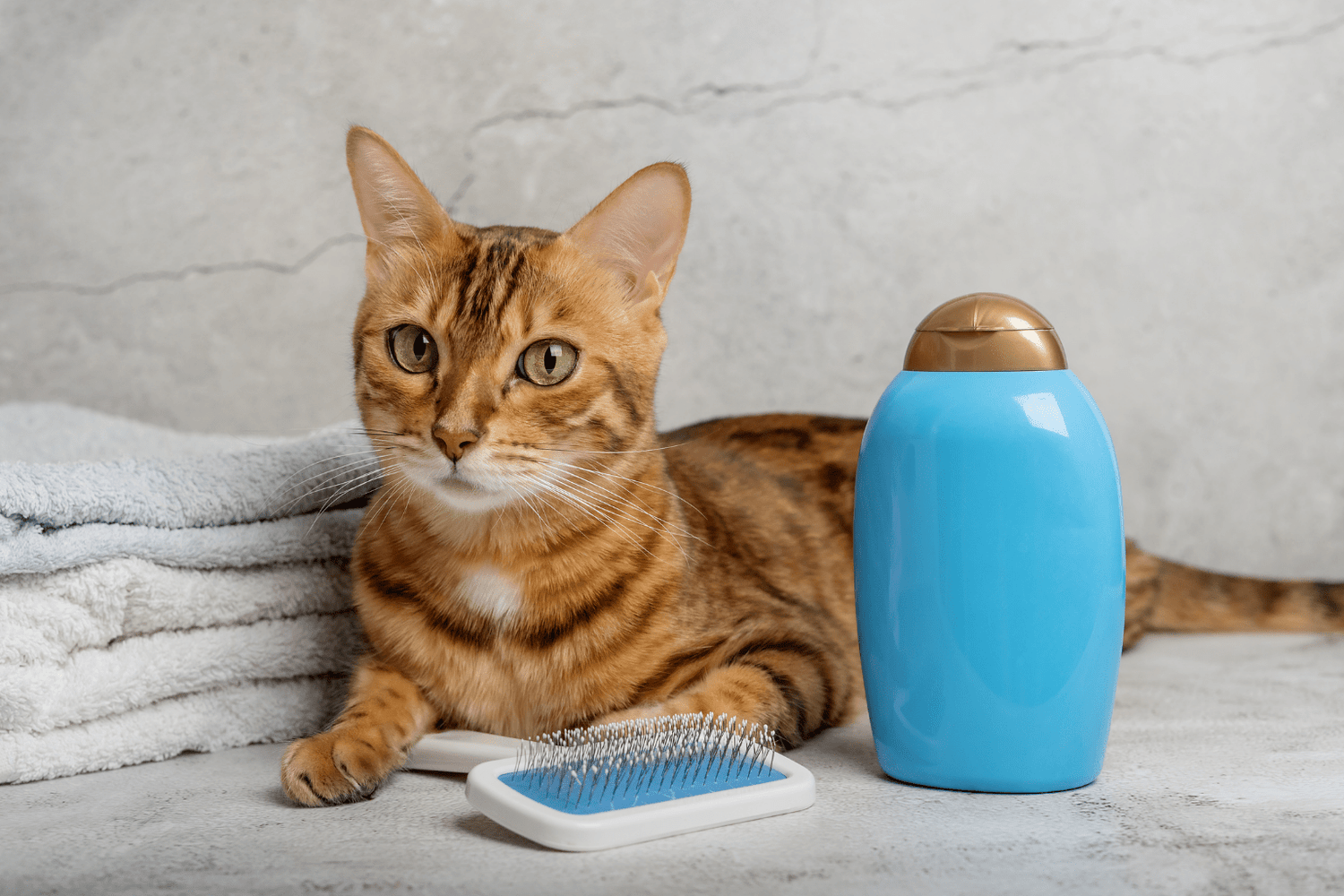Key Takeaways
- Cats spend a significant portion of their time grooming themselves, but shampooing is sometimes necessary for their health and comfort.
- Bathing cats can be essential if they get dirty, have mobility issues, or require medical baths.
- Knowing when and how to bathe cats safely can make the process less stressful for both pets and owners.
- Proper bathing techniques can help turn bath time into a manageable and positive routine.
Table of Contents
- Should You Shampoo Your Cat? Understanding Feline Grooming Needs
- Cat Shampoos 101: What's Safe (And What Isn't)?
- How Often Should You Bathe Your Cat? Real-Life Schedules
- Getting Ready: The Stress-Free Cat Bath Setup
- Step-by-Step: How to Shampoo Your Cat Without Drama
- Drying & Aftercare: Ensuring Your Cat's Comfort Post-Bath
- Common Cat Bathing Problems (And BestLife4Pets Solutions)
- Wet vs. Dry Shampooing: Which Method is Right for Your Cat?
- Can I Use Human or Dog Shampoos on Cats? Read Before You Reach
- Choosing the Best Cat Shampoo: Tips from BestLife4Pets
- Beyond Bath Day: Keeping Cats Clean Between Shampoos
- Why Choose BestLife4Pets? Nurture Bath Time With Nature
- Shampooing Cats FAQ: Your Top Bathing Questions Answered
- The Natural Pet Parent's Verdict: Making Bath Time Better
- Looking Ahead: The Future of Feline Hygiene Care
Shampooing Cats: The Caring Pet Parent's Guide to Happier Bath Days
Most cats spend 30-50% of their waking hours grooming themselves, yet there are times when shampooing cats becomes essential for their health and comfort. Whether your feline friend has gotten into something messy, struggles with mobility issues, or needs medical bathing support, understanding when and how to bathe cats safely can transform a stressful experience into a manageable routine.
The key lies in recognizing that not all cats need regular baths, but when they do, using the right approach and natural products makes all the difference for both you and your pet.
For cats with mobility issues or joint pain, supporting their comfort during bath time can make the process much easier for both pets and owners.
Should You Shampoo Your Cat? Understanding Feline Grooming Needs
Healthy cats are remarkably efficient self-groomers, but several situations call for human intervention. Senior cats, overweight cats, and long-haired breeds often struggle to reach all areas effectively. Medical conditions like arthritis or skin allergies can also interfere with natural grooming abilities.
Shampooing cats becomes necessary when they've encountered sticky substances, developed oily coats, or need allergen removal for sensitive family members. Unlike dogs, cats don't require weekly baths, most benefit from bathing only when specific needs arise.
Do All Cats Need Baths?
Indoor cats: Every 4-6 months or as needed
Outdoor cats: Monthly during active seasons
Senior/disabled cats: Every 6-8 weeks
Long-haired breeds: Every 6-8 weeks to prevent matting
Cat Shampoos 101: What's Safe (And What Isn't)?

Cat skin has a different pH balance than human or dog skin, requiring specially formulated products. Never use human shampoos, dish soap, or dog products on cats, as these can cause irritation, dryness, or toxic reactions if ingested during grooming.
Safe cat shampoos come in several forms: gentle everyday formulas, sensitive skin varieties, odor-control options, and waterless alternatives. Look for products free from sulfates, parabens, artificial fragrances, and essential oils, which can be harmful to cats.
| Shampoo Type | Best For | Key Features |
|---|---|---|
| Gentle Daily | Regular maintenance | Mild, pH-balanced, fragrance-free |
| Sensitive Skin | Allergies, irritation | Hypoallergenic, soothing ingredients |
| Waterless/Dry | Water-averse cats | No-rinse formula, quick application |
How Often Should You Bathe Your Cat? Real-Life Schedules
Bathing frequency depends entirely on your cat's lifestyle, health, and coat type. Most healthy indoor cats need baths only 3-4 times per year, while cats with medical conditions or outdoor access may require monthly attention.
Over-bathing strips natural oils and can cause skin dryness or increased stress. Signs your cat needs a bath include visible dirt, oily feel to the coat, strong odors, or inability to groom effectively due to age or mobility issues.
Getting Ready: The Stress-Free Cat Bath Setup
Preparation prevents chaos. Gather everything beforehand: cat-specific shampoo, two absorbent towels, non-slip bath mat, wide cup for rinsing, and high-value treats. Trim your cat's nails 24 hours before bathing to minimize scratching.
Create a calm environment by closing doors, removing breakable items, and ensuring the room temperature is comfortable. Brush out any mats before wetting the coat, as water tightens tangles.
For anxious cats, place a familiar towel in the tub and use treats to create positive associations with the bathing area before introducing water.
Step-by-Step: How to Shampoo Your Cat Without Drama

Fill the tub with 2-3 inches of lukewarm water (99-102°F). Wet your cat gradually, starting from the neck down, avoiding the face entirely. Use a cup or gentle spray attachment to saturate the coat thoroughly.
Apply a small amount of cat shampoo, working it gently through the fur with your fingertips. Focus on areas that get dirtiest: paws, belly, and base of the tail. Allow the shampoo to work for the time specified on the product label.
Rinse thoroughly, leftover residue causes itching and flaking. Triple-check that all soap is removed, especially from thick-coated areas. Clean the face separately with a damp cloth, never submerging your cat's head.
Drying & Aftercare: Ensuring Your Cat's Comfort Post-Bath
Immediately wrap your cat in a large, absorbent towel and gently pat, never rub, to remove excess water. Most cats prefer air-drying in a warm, draft-free room rather than blow-dryers, which can cause additional stress.
If using a dryer, choose the coolest setting and maintain distance. Long-haired cats benefit from gentle combing while damp to prevent tangles from forming as they dry.
Offer treats and praise throughout the drying process. Monitor your cat for 24 hours post-bath, excessive grooming or hiding may indicate stress that needs addressing for future baths.
Common Cat Bathing Problems (And BestLife4Pets Solutions)
Even well-prepared pet parents encounter challenges when shampooing cats. Scratching and biting are natural defensive responses, prevent injury by trimming nails beforehand and using gentle but secure holds. If your cat becomes aggressive, consider wrapping them in a towel with only the area being washed exposed.
Shampoo residue causes persistent itching and flaking. Always rinse twice as long as you think necessary, paying special attention to thick undercoats. If your cat develops skin irritation post-bath, our Cat Itchy Skin Relief & Hair Loss Treatment can help support healthy skin and reduce discomfort naturally while their skin recovers.
Lingering odors after bathing often indicate incomplete rinsing or underlying dental issues. A thorough final rinse followed by proper drying usually resolves coat odors, but persistent smells warrant a veterinary checkup. For more on feline dental care, see why brush cats teeth.
When to Call Your Vet: Contact your veterinarian if your cat shows signs of skin reaction, excessive scratching lasting more than 24 hours, or behavioral changes that persist beyond the bathing day. This information is not a substitute for professional veterinary advice.
Wet vs. Dry Shampooing: Which Method is Right for Your Cat?

Traditional wet shampooing provides the deepest clean but requires water tolerance and more preparation time. Dry shampooing offers a gentler alternative for water-phobic cats, elderly pets with mobility issues, or quick touch-ups between full baths.
Waterless formulas work by absorbing oils and debris without requiring rinsing. While they can't replace deep cleaning for heavily soiled coats, dry options excel for maintaining cleanliness in cats with chronic illnesses or those recovering from medical procedures.
| Method | Cleaning Power | Stress Level | Best For |
|---|---|---|---|
| Wet Shampooing | Deep, thorough clean | Moderate to high | Heavy soiling, medical needs |
| Dry Shampooing | Surface cleaning | Low | Maintenance, water-averse cats |
Can I Use Human or Dog Shampoos on Cats? Read Before You Reach
Even "gentle" baby shampoos pose risks for cats due to pH differences and ingredients that are safe for humans but toxic to felines. Cat skin is more alkaline than human skin, requiring specifically formulated products to maintain healthy barrier function. For more on the science behind feline grooming, see cat grooming.
Dog shampoos often contain essential oils, fragrances, or concentrations unsuitable for cats' sensitive systems. Cats groom themselves extensively, ingesting any residue left on their coat, making ingredient safety even more critical.
Choosing the Best Cat Shampoo: Tips from BestLife4Pets
Quality cat shampoos prioritize safety and effectiveness without harsh chemicals. Look for natural, vet-approved formulations that support your cat's skin health rather than simply masking problems with artificial fragrances.
Our community has found success with gentle, natural approaches that work with cats' biology rather than against it. Bailey, a rescue tabby with sensitive skin, showed remarkable improvement when her family switched to natural support remedies that addressed her underlying skin comfort needs.
The best products offer multi-symptom support while remaining safe if ingested during grooming. Consider formulations that provide ongoing skin and coat support beyond just cleaning, helping maintain your cat's natural defenses between baths. For more tips on supporting your cat's health, read can cats get a cold or respiratory infection.
Beyond Bath Day: Keeping Cats Clean Between Shampoos

Regular brushing reduces the need for frequent shampooing by distributing natural oils and removing loose fur before it becomes matted. Short-haired cats benefit from weekly brushing, while long-haired breeds need daily attention.
Spot-cleaning with pet-safe wipes addresses minor messes without full baths. Focus on paws after litter box use and the tail area where cats sometimes struggle to reach effectively. Maintaining excellent litter box hygiene also reduces the need for frequent bathing.
Natural homeopathic support can help maintain skin and coat health between baths, supporting your cat's comfort and reducing the buildup of oils and debris that necessitate more frequent washing. For a comprehensive approach, explore our Cat Health Product Bundles.
Why Choose BestLife4Pets? Nurture Bath Time With Nature
Our natural, vet-formulated remedies support cats through the stress of bathing and beyond. Unlike liquid alternatives, our easy-to-use pellets provide gentle support for skin comfort, stress relief, and overall wellness without the mess or difficulty of liquid administration.
For anxious cats, our Pet Relax Cat Calming Anxiety Relief can help promote a calm disposition before and during bath time. If your cat experiences skin irritation or discomfort, our Cat Itchy Skin Relief & Hair Loss Treatment supports healthy skin naturally.
Thousands of pet parents and rescue organizations trust our field-tested formulations because they work with your cat's natural healing abilities. When shampooing cats becomes necessary, having natural support makes the experience better for everyone involved.
Ready for a more natural approach to your cat's bathing routine? Explore our range of gentle, homeopathic support options designed specifically for feline wellness. Not a substitute for professional veterinary advice.
Shampooing Cats FAQ: Your Top Bathing Questions Answered
How often should I bathe my cat?
Most healthy cats need baths every 4-8 weeks maximum. Long-haired, elderly, or cats with skin conditions may require more frequent bathing, while short-haired indoor cats often need less.
What's the safest shampoo for cats?
Use only cat-specific formulations with natural ingredients. Avoid human or dog shampoos, essential oils, and artificial fragrances that can irritate sensitive feline skin or cause toxicity.
How do I bathe a cat that hates water?
Start with minimal water depth, use lukewarm temperature, and consider dry shampooing alternatives. Wrap anxious cats gently in towels and work in small sections to reduce stress. For more advice on handling cats with special needs, see can cats walk with a broken leg.
What if shampoo gets in my cat's eyes or ears?
Rinse immediately with clean water. For eyes, flush gently from inner to outer corner. If irritation persists beyond a few hours, contact your veterinarian.
How can I avoid getting scratched during bath time?
Trim nails beforehand, use non-slip mats for stability, and maintain calm energy. Secure holds without restraining too tightly, and consider having a helper for anxious cats.
Do indoor cats really need baths?
Indoor cats typically need fewer baths than outdoor cats, but shampooing cats becomes necessary for medical reasons, allergen reduction, or when self-grooming isn't sufficient due to age or health issues.
The Natural Pet Parent's Verdict: Making Bath Time Better

Successful cat bathing combines preparation, patience, and the right products. Natural approaches consistently outperform chemical-heavy alternatives because they work with your cat's biology rather than overwhelming their sensitive systems with harsh ingredients.
The most effective shampooing cats strategies focus on minimizing stress while maximizing cleanliness. This means choosing gentle, vet-approved formulations that support skin health long after the bath ends, rather than products that simply clean and leave cats vulnerable to dryness or irritation.
Our decade of experience with thousands of cats reveals that those receiving natural homeopathic support before, during, and after bathing show significantly less stress and better skin outcomes. The pellet format eliminates the guesswork and mess of liquid alternatives while providing consistent, reliable support.
Key Success Factors: Temperature consistency, thorough rinsing, natural product selection, and post-bath comfort support create positive bathing experiences that benefit both cats and their families. For more scientific insight into feline skin health, see this external resource.
Looking Ahead: The Future of Feline Hygiene Care
Emerging research on feline skin microbiomes suggests that supporting natural bacterial balance may be more important than frequent cleaning. This validates the natural approach many pet parents are already embracing, focusing on gentle maintenance rather than aggressive washing schedules.
As cats live longer, age-related grooming challenges will increase demand for senior-friendly bathing solutions. Waterless options and mobility-accommodating techniques will become increasingly valuable for maintaining hygiene in cats who struggle with traditional bathing methods.
The trend toward multi-pet households also drives innovation in efficient, stress-reducing bathing protocols. Natural formulations that work safely across different ages and health conditions within the same family simplify care while maintaining individual pet wellness needs.
Climate change impacts on indoor air quality mean shampooing cats may become more frequent for allergy management. Natural, gentle approaches that can be used more regularly without compromising skin health position pet parents for success in changing environmental conditions.
Frequently Asked Questions
How often should I bathe my cat based on their lifestyle and breed?
Most cats groom themselves well and only need baths occasionally. Long-haired breeds, senior cats, or those with outdoor lifestyles may benefit from bathing every few weeks to keep their coat clean. For indoor short-haired cats, bathing every few months or only when necessary is usually enough.
What types of shampoos are safe to use on cats, and why shouldn't I use human or dog shampoos?
Use shampoos specifically formulated for cats to protect their sensitive skin and unique pH balance. Human or dog shampoos can irritate a cat’s skin and cause discomfort because they are designed for different skin types and may contain ingredients harmful to cats.
What are the best techniques to reduce stress and ensure safety when shampooing my cat?
Prepare a calm, warm space with all supplies ready before starting. Use gentle, slow movements and speak softly to your cat. Keep water shallow and avoid the face, and consider enlisting a helper to gently hold your cat if needed. Reward your cat with praise or treats afterward to create positive associations.
How can I care for cats with mobility issues or medical conditions during bath time?
For cats with mobility challenges, support their body carefully and avoid slippery surfaces by using a non-slip mat. Use gentle, minimal handling and consider shorter baths focused on key areas. If bathing is stressful, consult your vet about alternative cleaning methods or supportive remedies to ease discomfort.



